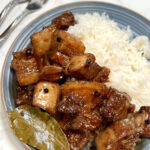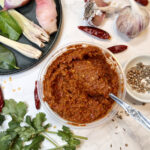Tteokbokki is a delicious Korean snack made up of soft and chewy rice cakes that’s coated in a spicy and sweet glaze. Just like in the streets of Korea, this dish is incredibly easy to prepare by simply throwing everything into one pot!
What is tteokbokki?
Tteokbokki is one of the more popular Korean foods, typically sold from street vendors, local markets, or simply cooked at home as a quick snack.
It’s made up of soft, slightly chewy rice cakes that’s simmered in a spicy, sweet, and savory sauce made up of gochujang, a Korean red pepper paste.
It’s then mixed with a delicious combination of add-ins including: fish cakes, green cabbage, boiled eggs, and scallions for an addictive and umami-rich meal.

In fact, the early versions of tteokbokki were actually very different compared to the modern vibrant red dish we see today. Gungjung tteokbokki was traditionally a royal rice cake dish, consumed by high-class individuals back in the Joseon Dynasty (1392 – 1910). Instead of red pepper paste as the prominent ingredient, it was more based on soy sauce, with beef, mushrooms, and other vegetables as the add-ins.
The more familiar tteokbokki was only very recently introduced in the 1950s, when gochujang was eventually added to the mix. This ultimately transformed the traditional dish into the red and spicy Korean street food that’s widely popular to this day.
Looking for more spicy recipes? Here’s a couple more from our recent chili oil series!:
- 10-Minute Chili Oil Noodles
- Mapo Tofu
- Chili Peanut Bok Choy
- Chili Garlic Sinangag (Filipino Fried Rice)
Ingredients
- 400 g Korean cylinder rice cakes (garaetteok), soaked for ~30 mins if using refrigerated or frozen cakes
- 1 tsp sesame oil
- 3 cups anchovy broth (can be substituted with dashi stock, veggie stock, chicken stock, or water)
Anchovy broth (omit if using instant stocks or water)
- 3 cups water
- 15 g dried anchovies, head and intestines removed
- 1 piece dried kelp (~3×3-inch square)
- 1/4 onion, thinly sliced
Tteokbokki paste
- 2.5 tbsp Korean hot pepper paste (gochujang), according to spice tolerance
- 1-3 tbsp fine Korean hot pepper flakes (gochugaru), according to spice tolerance
- 1 tbsp soy sauce
- 1 tbsp sugar (more or less, to taste)
- 1 tbsp corn syrup (if omitting, can be substituted with an extra 1/2 tbsp sugar)
Add-ins
- 100 g Korean fish cakes (eomuk), cut into triangles
- 50 g cabbage, chopped
- 2-3 hardboiled eggs
- 1 stalk green onion, chopped
Soaking the rice cakes
Korean rice cakes can be found in most Asian groceries, either frozen, refrigerated, or even better, fresh.
Your best bet would be to check your local Korean market if you have one, since these locations tend to carry the fresh kinds. If you can’t find fresh rice cakes, the refrigerated or frozen ones work just fine.
When working with refrigerated rice cakes, I highly recommend soaking these beforehand in lukewarm water for about 30-60 minutes or so. If frozen, you could even go a little bit longer.
Although you can totally skip this step and just dump them directly into your simmering tteokbokki liquid, soaking does make a considerable difference in the texture of the rice cakes, since non-fresh rice cakes tend to be more dry and hard.
The soaking process essentially helps to rehydrate the core of the rice cakes, giving us more consistency in terms of its texture and chewiness!
*(Note that if you are using fresh rice cakes, then soaking can be skipped completely)
Anchovy stock
Anchovy stock gives our tteokbokki sauce a savory and umami-rich flavor. You’ll definitely be able to taste a difference (even very subtle) of a tteokbokki using anchovy stock and one that uses just plain water.
Anchovy stock can easily be made at home by boiling together cleaned anchovies, dried kelp, and onion, but conveniently, you can also purchase ready-made anchovy stock sachets that you just need to simmer in water for a couple minutes! You can typically find these being sold in most Korean groceries or Asian markets.
In a pinch, you can definitely use instant dashi stock as your next best substitute, or if you can’t access this, any kind of stock base (chicken, vegetable, etc.) also works.
Instructions
Prepare the anchovy stock:
In a pot, combine together the water, anchovies, dried kelp, and onion. Bring this to a boil, then let simmer on medium-low for 10 minutes, uncovered.
After 10 minutes, strain the stock to remove the anchovies, dried kelp, and onion. Set aside until use.
Prepare the tteokbokki:
Prepare the tteokbokki paste by mixing all the ingredients together until evenly combined.

Add the anchovy stock and tteokbokki paste together in a pot or a deep pan. Mix thoroughly to combine until no clumps of paste are left. Bring this mixture to a light boil.

Once the mixture is boiling, add in your rice cakes and let simmer until slightly softened.
*Depending on how fresh your rice cakes are, this might take anywhere between 5-10 minutes of simmering to soften completely.

Once the rice cakes have softened, add in the fish cakes, cabbage, green onions, sesame oil, and boiled eggs. Gently stir until evenly combined.
Continue to simmer the tteokbokki until your desired consistency of the sauce is reached.


Serve warm and enjoy!

Can I reheat tteokbokki?
Yes! Usually if I have tteokbokki leftover in the fridge, I’ll just place it directly into a sauce pan with a little bit of extra stock, stirring occasionally. You’ll want to let it simmer over medium heat for about 5 minutes, or until the rice cakes have softened up again.
Disclosure: Some links on this page are affiliate links, meaning that at no additional cost to you, we may receive compensation from purchases made through these links. As an Amazon Associate, I can earn from qualifying purchases.








Pingback: Taiwanese Popcorn Chicken | Iankewks
Pingback: Vietnamese Pizza (Banh Trang Nuong) | Iankewks